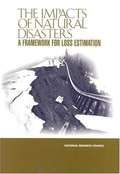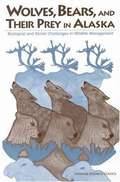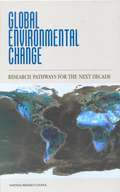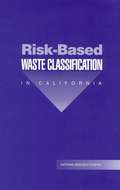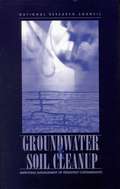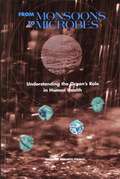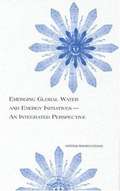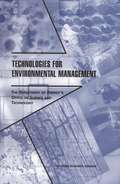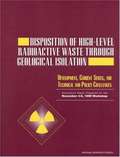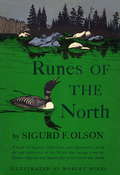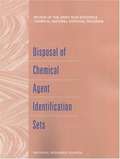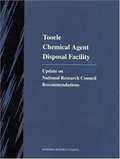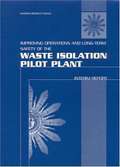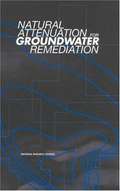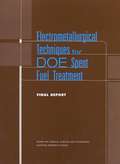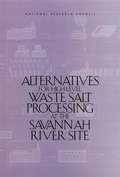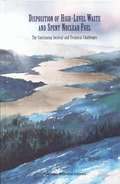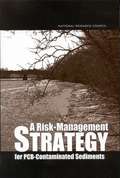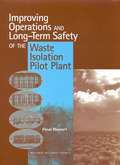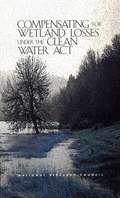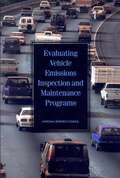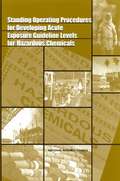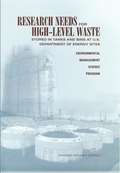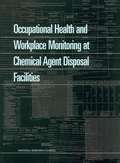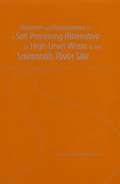- Table View
- List View
The Impacts of Natural Disasters: A Framework for Loss Estimation
by National Research CouncilWe in the United States have almost come to accept natural disasters as part of our nation's social fabric. News of property damage, economic and social disruption, and injuries follow earthquakes, fires, floods and hurricanes. Surprisingly, however, the total losses that follow these natural disasters are not consistently calculated. We have no formal system in either the public or private sector for compiling this information. The National Academies recommends what types of data should be assembled and tracked.
Wolves, Bears, and Their Prey in Alaska: Biological and Social Challenges in Wildlife Management
by National Research CouncilThis book assesses Alaskan wolf and bear management programs from scientific and economic perspectives. Relevant factors that should be taken into account when evaluating the utility of such programs are identified. The assessment includes a review of current scientific knowledge about the dynamics and management of large mammalian predator-prey relationships and human harvest of wildlife in northern ecosystems, and an evaluation of the extent to which existing research and management data allow prediction of the outcome of wolf management or control programs and grizzly bear management programs. Included is an evaluation of available economic studies and methodologies for estimating the costs and benefits of predator control programs in Alaska.
Global Environmental Change: Research Pathways for the Next Decade
by National Research CouncilHow can we understand and rise to the environmental challenges of global change? One clear answer is to understand the science of global change, not solely in terms of the processes that control changes in climate and the composition of the atmosphere, but in how ecosystems and human society interact with these changes. In the last two decades of the twentieth century, a number of such research efforts--supported by computer and satellite technology--have been launched. Yet many opportunities for integration remain unexploited, and many fundamental questions remain about the earth's capacity to support a growing human population.This volume encourages a renewed commitment to understanding global change and sets a direction for research in the decade ahead. Through case studies the book explores what can be learned from the lessons of the past 20 years and what are the outstanding scientific questions. Highlights include: Research imperatives and strategies for investigators in the areas of atmospheric chemistry, climate, ecosystem studies, and human dimensions of global change.The context of climate change, including lessons to be gleaned from paleoclimatology.Human responses to--and forcing of--projected global change. This book offers a comprehensive overview of global change research to date and provides a framework for answering urgent questions.
Risk-Based Waste Classification in California
by Committee on Risk-Based Criteria for Non-RCRA Hazardous WasteThe National Academies Press (NAP)--publisher for the National Academies--publishes more than 200 books a year offering the most authoritative views, definitive information, and groundbreaking recommendations on a wide range of topics in science, engineering, and health. Our books are unique in that they are authored by the nation's leading experts in every scientific field.
Ground Water & Soil Cleanup: Improving Management of Persistent Contaminants
by National Research CouncilThis book presents a comprehensive, up-to-date review of technologies for cleaning up contaminants in groundwater and soil. It provides a special focus on three classes of contaminants that have proven very difficult to treat once released to the subsurface: metals, radionuclides, and dense nonaqueous-phase liquids such as chlorinated solvents.Groundwater and Soil Cleanup was commissioned by the Department of Energy (DOE) as part of its program to clean up contamination in the nuclear weapons production complex. In addition to a review of remediation technologies, the book describes new trends in regulation of contaminated sites and assesses DOE's program for developing new subsurface cleanup technologies.
From Monsoons to Microbes: Understanding the Ocean's Role in Human Health
by National Research CouncilWhat can sharks teach us about our immune system? What can horseshoe crabs show us about eyesight?The more we learn about the ocean, the more we realize how critical these vast bodies of water are to our health and well-being. Sometimes the ocean helps us, as when a marine organism yields a new medical treatment. At other times, the ocean poses the threat of coastal storm surges or toxic algal blooms.From Monsoons to Microbes offers a deeper look into the oceans that surround us, often nuturing yet sometimes harming humankind. This book explores the links among physical oceanography, public health, epidemiology, marine biology, and medicine in understanding what the ocean has to offer. It will help readers grasp such important points as: How the ocean's sweeping physical processes create long-term phenomena such as El Nino and short-term disastrous events such as tsunamis--including what communities can do to prepare.What medicines and nutritional products have come from the ocean and what the prospects are for more such discoveries.How estuaries work--where salt and fresh water meet--and what can go wrong, as in the 7,000 square mile "dead zone" at the out-flow of the Mississippi River.How the growing demand for seafood and the expansion of ocean-going transport has increased our exposure to infectious agents--and how these agents can be tracked down and fought.Why "red tides" of toxic algae suddenly appear in previously unaffected coastal areas, and what happens when algal toxins find their way into our food supply or the air we breathe. The book recommends ways we can implement exciting new technologies to monitor the physics, chemistry, and biology of the ocean to recognize change as it happens. From the impact of worldwide atmospheric warming to the significance of exotic bacteria from submarine hydrothermal vents, the ocean has many depths left to explore.
Emerging Global Water and Energy Initiatives-- An Integrated Perspective
by Global Energy Water Cycle Experiment Gewex PanelThe National Academies Press (NAP)--publisher for the National Academies--publishes more than 200 books a year offering the most authoritative views, definitive information, and groundbreaking recommendations on a wide range of topics in science, engineering, and health. Our books are unique in that they are authored by the nation's leading experts in every scientific field.
Technologies For Environmental Management: The Department Of Energy's Office Of Science And Technology
by Board on Radioactive Waste ManagementThe National Academies Press (NAP)--publisher for the National Academies--publishes more than 200 books a year offering the most authoritative views, definitive information, and groundbreaking recommendations on a wide range of topics in science, engineering, and health. Our books are unique in that they are authored by the nation's leading experts in every scientific field.
Disposition of High-Level Radioactive Waste through Geological Isolation: Development, Current Status, and Technical and Policy Challenges
by Steering CommitteeThe National Academies Press (NAP)--publisher for the National Academies--publishes more than 200 books a year offering the most authoritative views, definitive information, and groundbreaking recommendations on a wide range of topics in science, engineering, and health. Our books are unique in that they are authored by the nation's leading experts in every scientific field.
Runes of the North
by Sigurd F. OlsonIn Runes of the North Sigurd F. Olson explores the haunting appeal of the wilderness. He recounts how the legends of the northern vastness of Canada and Alaska have influenced him, weaving the tales and myths with his own stories and experiences as an explorer, writer, grandfather, and biologist. Now available in paperback for the first time, Runes of the North is a mystical and reflective guide to the northern wilderness written with a oneness and communion with nature that is unique to Olson's pen. It is a work filled with beauty, wisdom, and renewal.
Disposal of Chemical Agent Identification Sets: Review of the Army Non-Stockpile Chemical Material Disposal Program
by National Research CouncilThe National Academies Press (NAP)--publisher for the National Academies--publishes more than 200 books a year offering the most authoritative views, definitive information, and groundbreaking recommendations on a wide range of topics in science, engineering, and health. Our books are unique in that they are authored by the nation's leading experts in every scientific field.
Tooele Chemical Agent Disposal Facility: Update on National Research Council Recommendations
by Committee on Review Evaluation of the Army Chemical Stockpile Disposal ProgramThe National Academies Press (NAP)--publisher for the National Academies--publishes more than 200 books a year offering the most authoritative views, definitive information, and groundbreaking recommendations on a wide range of topics in science, engineering, and health. Our books are unique in that they are authored by the nation's leading experts in every scientific field.
Improving Operations And Long-term Safety Of The: Interim Report
by Committee on the Waste Isolation Pilot PlantThe National Academies Press (NAP)--publisher for the National Academies--publishes more than 200 books a year offering the most authoritative views, definitive information, and groundbreaking recommendations on a wide range of topics in science, engineering, and health. Our books are unique in that they are authored by the nation's leading experts in every scientific field.
Natural Attenuation For Groundwater Remediation
by Committee on Intrinsic RemediationIn the past decade, officials responsible for clean-up of contaminated groundwater have increasingly turned to natural attenuation-essentially allowing naturally occurring processes to reduce the toxic potential of contaminants-versus engineered solutions. This saves both money and headaches. To the people in surrounding communities, though, it can appear that clean-up officials are simply walking away from contaminated sites.When is natural attenuation the appropriate approach to a clean-up? This book presents the consensus of a diverse committee, informed by the views of researchers, regulators, and community activists. The committee reviews the likely effectiveness of natural attenuation with different classes of contaminants-and describes how to evaluate the "footprints" of natural attenuation at a site to determine whether natural processes will provide adequate clean-up. Included are recommendations for regulatory change.The committee emphasizes the importance of the public's belief and attitudes toward remediation and provides guidance on involving community stakeholders throughout the clean-up process.The book explores how contamination occurs, explaining concepts and terms, and includes case studies from the Hanford nuclear site, military bases, as well as other sites. It provides historical background and important data on clean-up processes and goes on to offer critical reviews of 14 published protocols for evaluating natural attenuation.
Electrometallurgical Techniques for DOE Spent Fuel Treatment: FINAL REPORT
by Committee on Electrometallurgical Techniques for DOE Spent Fuel TreatmentThe National Academies Press (NAP)--publisher for the National Academies--publishes more than 200 books a year offering the most authoritative views, definitive information, and groundbreaking recommendations on a wide range of topics in science, engineering, and health. Our books are unique in that they are authored by the nation's leading experts in every scientific field.
Alternatives For High-level Waste Salt Processing At The Savannah River Site
by National Research CouncilAt the request of the US Department of Energy, the Committee provides a technical review of alternatives selected by representatives of the South Carolina site for processing the high-level radioactive waste salt solutions stored there in 48 below-grade tanks. Annotation c. Book News, Inc. , Portland, OR (booknews. com)
Disposition of High-level Waste and Spent Nuclear Fuel: The Continuing Societal and Technical Challenges
by National Research CouncilFocused attention by world leaders is needed to address the substantial challenges posed by disposal of spent nuclear fuel from reactors and high-level radioactive waste from processing such fuel. The biggest challenges in achieving safe and secure storage and permanent waste disposal are societal, although technical challenges remain. Disposition of radioactive wastes in a deep geological repository is a sound approach as long as it progresses through a stepwise decision-making process that takes advantage of technical advances, public participation, and international cooperation. Written for concerned citizens as well as policymakers, this book was sponsored by the U.S. Department of Energy, U.S. Nuclear Regulatory Commission, and waste management organizations in eight other countries.
A Risk-Management STRATEGY for PCB-Contaminated Sediments
by Committee on Remediation of PCB-Contaminated SedimentsThe National Academies Press (NAP)--publisher for the National Academies--publishes more than 200 books a year offering the most authoritative views, definitive information, and groundbreaking recommendations on a wide range of topics in science, engineering, and health. Our books are unique in that they are authored by the nation's leading experts in every scientific field.
Improving Operations AND Long-Term Safety OF THE Waste Isolation Pilot Plant: Final Report
by National Research CouncilThe National Academies Press (NAP)--publisher for the National Academies--publishes more than 200 books a year offering the most authoritative views, definitive information, and groundbreaking recommendations on a wide range of topics in science, engineering, and health. Our books are unique in that they are authored by the nation's leading experts in every scientific field.
Compensating For Wetland Losses Under The Clean Water Act
by Committee on Mitigating Wetland LossesRecognizing the importance of wetland protection, the Bush administration in 1988 endorsed the goal of “no net loss” of wetlands. Specifically, it directed that filling of wetlands should be avoided, and minimized when it cannot be avoided. When filling is permitted, compensatory mitigation must be undertaken; that is, wetlands must be restored, created, enhanced, and, in exceptional cases, preserved, to replace the permitted loss of wetland area and function, such as water quality improvement within the watershed. After more than a dozen years, the national commitment to “no net loss” of wetlands has been evaluated. This new book explores the adequacy of science and technology for replacing wetland function and the effectiveness of the federal program of compensatory mitigation in accomplishing the nation’s goal of clean water. It examines the regulatory framework for permitting wetland filling and requiring mitigation, compares the mitigation institutions that are in use, and addresses the problems that agencies face in ensuring sustainability of mitigated wetlands over the long term. Gleaning lessons from the mixed results of mitigation efforts to date, the book offers 10 practical guidelines for establishing and monitoring mitigated wetlands. It also recommends that federal, state, and local agencies undertake specific institutional reforms. This book will be important to anyone seeking a comprehensive understanding of the “no net loss” issue: policy makers, regulators, environmental scientists, educators, and wetland advocates.
Evaluating Vehicle Emissions Inspection and Maintenance Programs
by Committee on Vehicle Emission Inspection Maintenance ProgramsEmissions inspection and maintenance (I/M) programs subject vehicles to periodic inspections of their emission control systems. Despite widespread use of these programs in air-quality management, policy makers and the public have found a number of problems associated with them. Prominent among these issues is the perception that emissions benefits and other impacts of I/M programs have not been evaluated adequately. Evaluating Vehicle Emissions Inspection and Maintenance Programsassesses the effectiveness of these programs for reducing mobile source emissions. In this report, the committee evaluates the differences in the characteristics of motor vehicle emissions in areas with and without I/M programs, identifies criteria and methodologies for their evaluation, and recommends improvements to the programs. Most useful of all, this book will help summarize the observed benefits of these programs and how they can be redirected in the future to increase their effectiveness.
Standing Operating Procedures for Developing Acute Exposure Guideline Levels for Hazardous Chemicals
by Subcommittee on Acute Exposure Guideline LevelsStanding Operating Procedures for Developing Acute Exposure Guideline Levels for Hazardous Chemicals contains a detailed and comprehensive methodology for developing acute exposure guideline levels (AEGLs) for toxic substances from inhalation exposures. The book provides guidance on what documents and databases to use, toxicity endpoints that need to be evaluated, dosimetry corrections from animal to human exposures, selection of appropriate uncertainty factors to address the variability between animals and humans and within the human population, selection of modifying factors to address data deficiencies, time scaling, and quantitative cancer risk assessment. It also contains an example of a summary of a technical support document and an example of AEGL derivation. This book will be useful to persons in the derivation of levels from other exposure routes—both oral and dermal—as well as risk assessors in the government, academe, and private industry.
Research Needs For High-level Waste Stored In Tanks And Bins At U.s. Department Of Energy Sites: Environmental Management Science Program
by Committee on Long-Term Research Needs for Radioactive High-level Waste at Department of Energy SitesThe committee was charged to identify high-level waste problems that cannot be addressed effectively with current technologies, and to recommend areas of research by which the Department's Science Program can make significant contributions to solving these problems and adding to scientific knowledge generally. The members were selected for their expertise in various relevant fields. The report is not indexed. Annotation c. Book News, Inc. , Portland, OR (booknews. com)
Occupational Health and Workplace Monitoring at Chemical Agent Disposal Facilities
by National Research CouncilThe National Academies Press (NAP)--publisher for the National Academies--publishes more than 200 books a year offering the most authoritative views, definitive information, and groundbreaking recommendations on a wide range of topics in science, engineering, and health. Our books are unique in that they are authored by the nation's leading experts in every scientific field.
Research and Development on a Salt Processing Alternative for High-level Waste at the Savannah River Site
by Committee on Radionuclide Separation Processes for High-level Waste at the Savannah River SiteThe National Academies Press (NAP)--publisher for the National Academies--publishes more than 200 books a year offering the most authoritative views, definitive information, and groundbreaking recommendations on a wide range of topics in science, engineering, and health. Our books are unique in that they are authored by the nation's leading experts in every scientific field.
